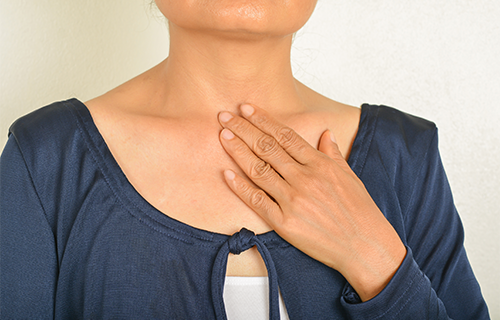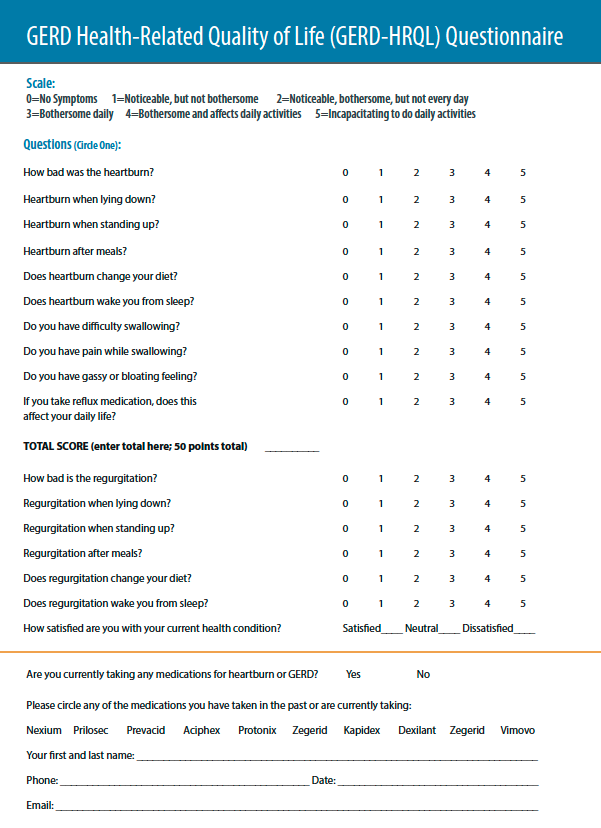
What is GERD?
Watch videos of GI Associates Physicians addressing commonly asked GI questions
In this disorder, contents from the stomach flow back into the esophagus, the tube that connects your mouth to your stomach. It is normal for some of the stomach contents to enter the esophagus, this often happens after eating, and is very brief; it does not cause symptoms and rarely happens at night. Reflux of acid becomes a problem and disease when these episodes cause symptoms or damage the esophagus. Damage occurs when there are frequent episodes of reflux, the material is very acidic or the acid remains in the esophagus and is unable to be cleared.
Why Does It Happen?
Typically, food travels from your mouth and then is squeezed down your esophagus with muscular contractions. The lower esophageal sphincter (LES), or band of muscular tissue separating your esophagus from the stomach, relaxes in response to the swallow, allowing the food to enter the stomach and then squeezes shut, preventing the food from reentering the esophagus. The diaphragm is a large muscle that contracts and relaxes during breathing and separates the chest cavity from the abdomen. The diaphragm strengthens the LES, especially during bending, coughing and straining. If the opening in the diaphragm through which the esophagus passes is too large, part of the stomach may slip through creating a hiatal hernia. This may make reflux more likely.
Symptoms of GERD:
The symptoms of GERD are variable but can include:
- Heartburn - A burning sensation in the chest when the esophagus lining is irritated by stomach contents. This happens most often after a meal
- Regurgitation - Acidic material and undigested food flows up into chest and mouth
- Trouble Swallowing
- Chest Pain - This can be a squeezing or burning pain that last from minutes to hours and may move to the back, neck, jaw or arms. It is important to make sure that this chest pain is not due to a heart condition.
- Water Brash or Increased Salivation - This is where the production of saliva is increased in response to reflux of stomach contents back up to the mouth.
- Globus Sensation - This is a feeling as if there is a lump in the throat.
- Pain with Swallowing - This is an unusual symptom and may mean that an ulcer is present in the esophagus
- Nausea
- Hoarseness or loss of voice
- Persistent Sore Throat
- Chronic Cough, new onset asthma or asthma only at night
- Recurrent Lung Infections
- Chronic Sinusitis
- Worsening Dental Disease
Diagnosis of GERD
Often this disease is diagnosed just by talking about your symptoms. If you have trouble swallowing, or if your symptoms do not resolve with treatment, further testing may be necessary which may include:
- Upper Endoscopy - A tube with light and camera is inserted through your mouth, into your throat, down to your stomach. Tissue samples can be taken during this procedure.
- Ambulatory pH Monitoring - At the time of an upper endoscopy, a tiny sensor can be placed at the area just above where your esophagus and stomach meet. It will record acid levels. By looking at this data it can be determined if your symptoms are due to reflux.
- Esophageal Manometry - A thin small tube is put through your nose or mouth down your throat and pressure readings are taken from multiple points on this tube as you sip small amounts of water when directed. This may be performed to rule out another condition.
How is GERD Treated?
There are a variety of treatment options for people who are diagnosed with GERD. These include both lifestyle changes, medications and, in severe cases, surgery.
Lifestyle Changes
- Dietary Changes, such as, the avoidance of caffeine, chocolate, alcohol, peppermint, and fatty foods.
- Avoid Large, Late Meals. Having a full stomach and then laying down can allow for more reflux. Try to allow at least 3 hours to pass between your last meal or snack and bedtime and avoid eating large meals that over distend your stomach.
- Quit Smoking. Smoking causes the LES to relax. It promotes acid production and damages the protective lining of the esophagus and stomach. Smoking also decreases the production of saliva that neutralizes the refluxed stomach acid. Finally, smoking promotes coughing, which, increases the amount of acid refluxed into the esophagus.
- Chew Gum or Oral Lozenges. As stated, saliva neutralizes the acid and these things increase saliva production which may also help get acid back into the stomach from the esophagus.
- Weight Loss, and avoid tight fitting clothes. These things increase the pressure in the abdomen so more stomach contents may go up into esophagus.
- Elevate the Head of your Bed. Increasing the head by 6-8 inches when sleeping, allows gravity to help prevent reflux.
Medicines
These are targeted at reducing the acid level by either neutralizing existing acid or preventing the production. The goal is to use the lowest possible dose of medicine to control symptoms but still prevent complications.
- Antacids (Tums, Maalox, Mylanta, etc) - These agents provide short term relief; they are fast acting and briefly neutralize acid so do not work for extended periods.
- Histamine-2 Antagonist (ranitidine-Zantac, famotidine-Pepcid, cimetidine-Tagamet, nizatidine-Axid, etc) - The main activator for the cells in the stomach that produce acid is histamine. These drugs block histamine from stimulating acid production so the level of acid is decreased.
- Proton Pump Inhibitors (omeprazole-Prilosec, esomeprazole-Nexium, lansoprazole-Prevacid, dexlansoprazole-Kapidex, pantoprazole-Protonix, rabeprazole-AcipHex, dexlansoprazole-Dexilant) - These agents actually target the cells of the stomach that produce acid and shut down the pump that secretes acid. They are the strongest and longest acting agents available.
Surgery
This technique is used for severe cases of GERD. Typically, it is used to repair a hiatal hernia and reinforce the LES. The most common technique used is wrapping the upper portion of the stomach around the lower esophagus; this is called a Nissen fundoplication.
What Can I Do?
- Follow the lifestyle modifications that were discussed above.
- Contact your doctor if you have a longstanding history of greater than 3 months of frequent heartburn or if you have trouble swallowing, unintentional weight loss, chest pain, choking, vomiting blood or dark colored stools.
Helpful information and lifestyle guidance is also available at www.RefluxMD.com
What Are The Complications?
Most people will not develop complications but without adequate treatment may develop:
- Ulcerations of the esophagus, stomach or small intestine
- Narrowing of the esophagus called strictures from damage to the esophagus from acids and the healing scar leaving the esophagus more narrow which may lead to trouble swallowing.
- Sometimes acid can be refluxed into the throat, leading to inflammation of the vocal cords, a sore throat and hoarse voice.
- If the acid is inhaled into the lungs, you can develop pneumonia or asthma or perhaps more permanent lung problems such as, fibrosis (scarring of the lungs) or bronchiectasis.
- With repeated exposure to acid, the cells at the bottom of the esophagus can transform to look more like stomach cells, this is called Barrett’s esophagus. There is a small risk that these cells can transform into esophageal cancer.
Self-Assessment
The Gastroesophageal Reflux Disease-Health Related Quality of Life (GERD-HRQL) instrument below was developed to provide a way of measuring symptom severity in gastroesophageal reflux disease (GERD). If you think you may have GERD, complete the assessment below, and schedule an appointment by calling 715-847-2558 or using our online form.

